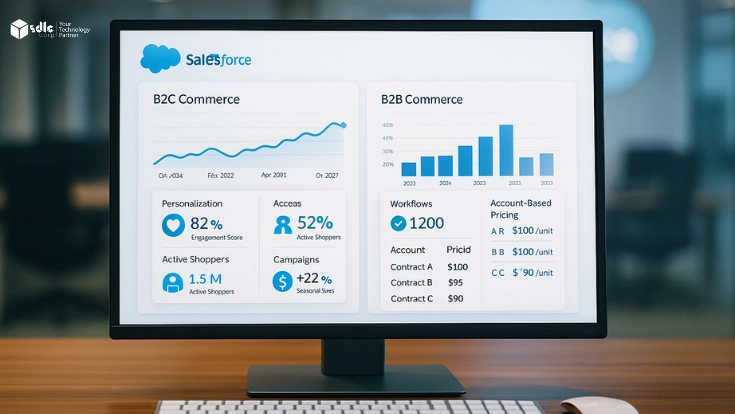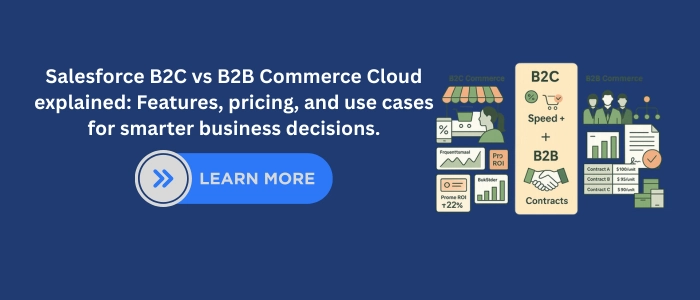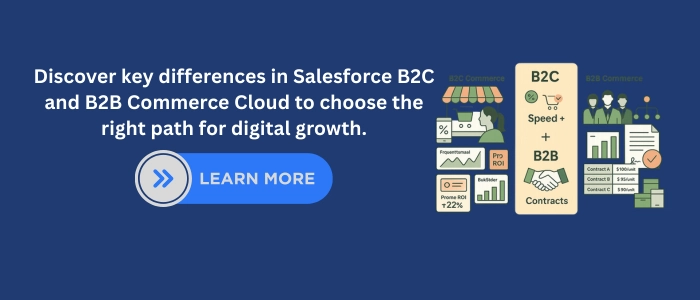Introduction
Salesforce B2C Commerce Cloud vs B2B Commerce is a critical choice for businesses moving into digital commerce. Both solutions belong to Salesforce Commerce Cloud, but they address different markets and buying behaviors.
B2C Commerce Cloud serves consumer-facing brands. It supports high-volume transactions, personalized shopping, and seamless checkout. B2B Commerce Cloud is designed for manufacturers, wholesalers, and distributors. It enables bulk orders, contract-based pricing, and account management.
Understanding the differences between Salesforce B2B and B2C Commerce is essential before committing to a platform. B2C emphasizes speed, marketing integration, and omnichannel experiences. B2B focuses on efficiency, order approvals, and long-term relationships.
If you’re new to Salesforce platforms, you may also want to explore our guide on Salesforce Implementation Services for a step-by-step approach to successful deployment.
Salesforce Commerce Cloud: A Quick Overview
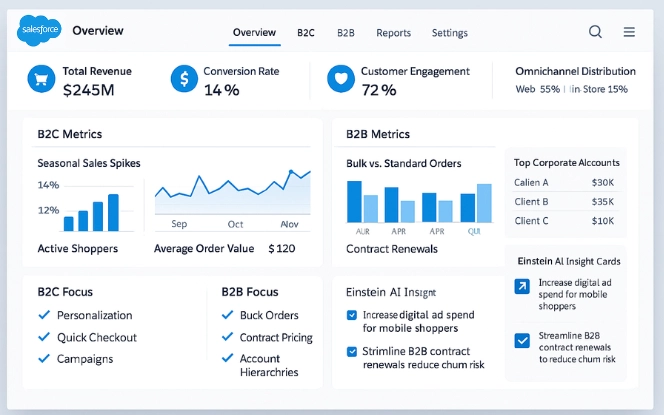
Salesforce Commerce Cloud is a cloud-based platform that helps businesses manage digital storefronts and unify sales across channels. It is widely adopted by global retailers, wholesalers, and manufacturers because of its scalability, flexibility, and integration with other Salesforce solutions.
Key Highlights:
SaaS Model: Cloud-native architecture ensures high availability and fast updates.
Scalability: Handles seasonal peaks and large enterprise workloads with ease.
Integration: Connects with Marketing Cloud, Service Cloud, and Einstein AI for insights.
Security: Built-in safeguards protect transactions and customer data.
Commerce Cloud has two distinct versions:
B2C Commerce Cloud, which focuses on consumer-facing businesses with high-volume transactions and personalized experiences.
B2B Commerce Cloud, which supports bulk orders, contract pricing, and account-based workflows.
For hybrid companies serving both consumers and enterprises, Salesforce often recommends combining both solutions. This ensures that businesses can meet the fast-moving needs of shoppers while managing complex corporate orders.
Understanding B2C Commerce Cloud
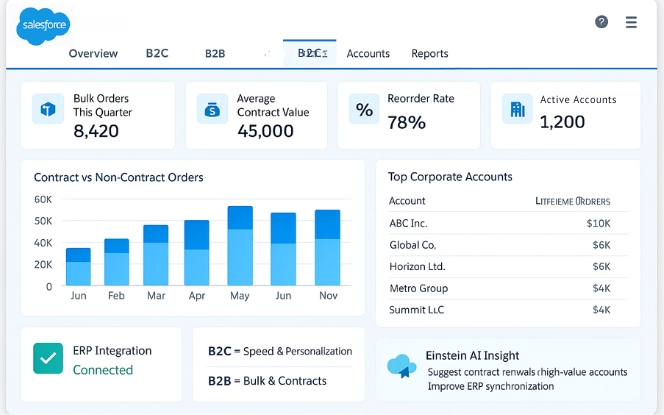
B2C Commerce Cloud is tailored for industries like fashion, electronics, and lifestyle brands. It enables companies to run scalable, consumer-focused online stores with emphasis on speed, convenience, and personalization.
Core Capabilities:
Personalization: AI-driven recommendations enhance shopping experiences.
Omnichannel Commerce: Consistent experiences across web, app, and in-store.
Dynamic Promotions: Seasonal campaigns and loyalty programs to drive engagement.
Analytics: Real-time reporting on consumer behavior and product performance.
Why It Matters:
Handles spikes in traffic during promotions.
Offers flexibility to design modern, visually appealing storefronts.
Supports quick checkouts and mobile-first designs.
Understanding B2B Commerce Cloud
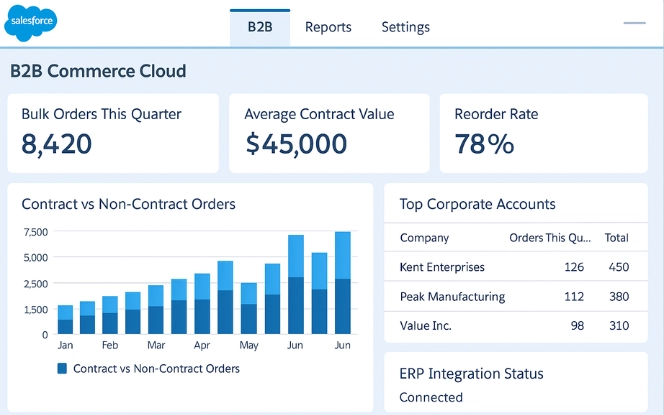
B2B Commerce Cloud serves enterprises such as manufacturers, distributors, and wholesalers. It emphasizes efficiency in handling large, complex transactions.
Core Capabilities:
Account-Based Purchasing: Supports corporate profiles, role hierarchies, and approval processes.
Flexible Pricing Models: Negotiated contracts, tiered discounts, and custom catalogs.
Bulk Orders: Designed for recurring purchases and high-value transactions.
ERP Integration: Connects with systems for inventory, logistics, and finance.
Why It Matters:
Buyers can self-serve, reorder, and manage invoices online.
Reduces manual workflows by automating procurement.
Ensures accuracy with approval-based order cycles.
For related insights, see how Salesforce Integration Services improve B2B order management and workflows.
Key Differences Between B2B and B2C Commerce
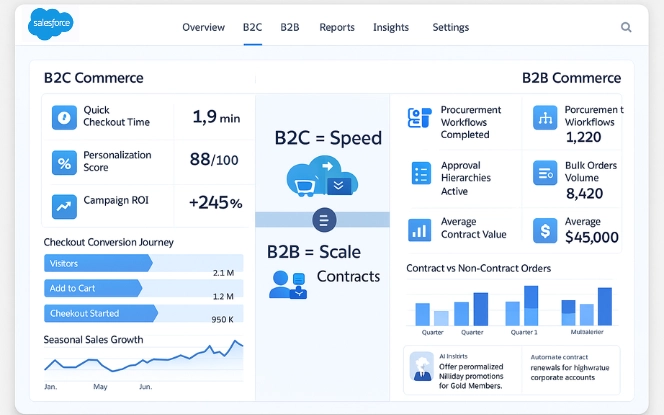
The differences between Salesforce B2B and B2C Commerce become clear when looking at customers, orders, workflows, and pricing.
1. Customers
B2C: Individual shoppers looking for convenience.
B2B: Corporate buyers with approval hierarchies.
2. Orders
B2C: High frequency, small value.
B2B: Lower frequency, large value. This is the essence of Salesforce B2B Commerce Cloud order volume vs B2C.
3. Checkout
B2C: Optimized for speed and simplicity.
B2B: Includes approvals, quotes, and contract terms.
4. Pricing
B2C: Fixed prices with promotions.
B2B: Negotiated contracts, bulk discounts.
5. Personalization
B2C: Marketing campaigns and recommendations.
B2B: Account-specific pricing and catalogs.
These differences show why choosing the right platform matters. A B2C business that sells fast-moving products would not benefit from the complexity of B2B features. Likewise, a wholesaler cannot run its operations on a B2C system.
By understanding these contrasts, organizations can align their commerce strategy with their target audience.
Technical Comparison: Salesforce Commerce Cloud Features B2B vs B2C
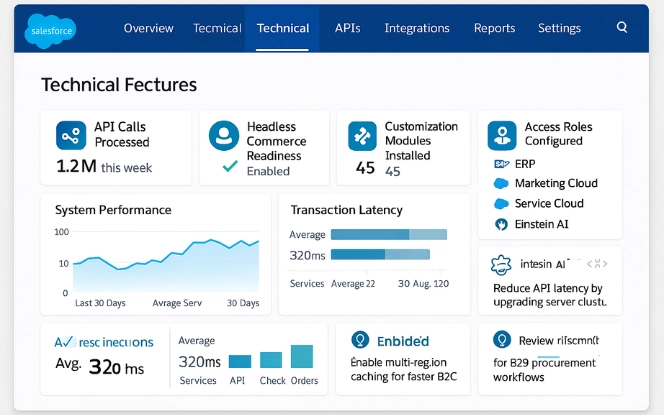
Examining Salesforce Commerce Cloud features B2B vs B2C reveals how each solution handles integration, customization, and scalability.
- Integration: Both support APIs and headless commerce. B2B often requires tighter ERP integration for contracts, logistics, and inventory.
- Scalability: B2C must support sudden spikes in traffic, like flash sales. B2B scales for consistent, large orders.
- Customization: B2C storefronts allow creative design. B2B storefronts are structured for function over aesthetics.
- Access Control: B2B uses role-based permissions for procurement teams. B2C relies on secure payment and account management for individuals.
Both platforms share Salesforce’s cloud architecture, AI capabilities, and security. But the focus differs. B2C is built for agility and consumer engagement. B2B is built for reliability and workflow management.
This technical split ensures each platform fits its audience. It also highlights why companies with hybrid models often use both.
Technology Stack Comparison: B2B vs B2C Salesforce Commerce
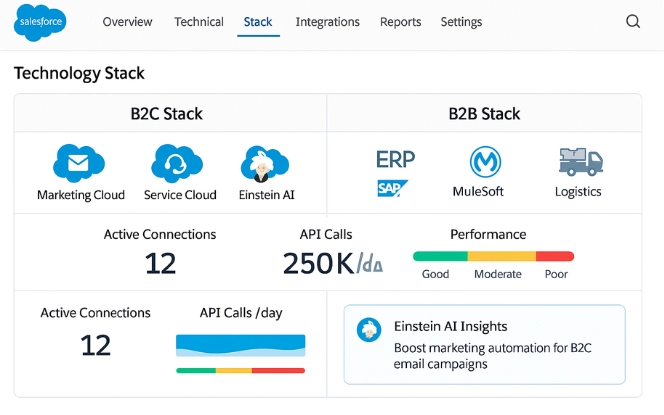
A technology stack comparison: B2B vs B2C Salesforce Commerce shows distinct integration paths.
- B2C Stack: Links with Marketing Cloud, Service Cloud, and Einstein AI. This helps businesses create personalized campaigns and customer support systems.
- B2B Stack: Connects with ERP tools like SAP or Oracle. This ensures smooth handling of contracts, pricing, and supply chains.
Both share Salesforce’s underlying infrastructure, APIs, and cloud-native security. Businesses can also use MuleSoft for integration.
Still, the level of dependency differs. B2C relies heavily on marketing data. B2B depends on inventory, logistics, and financial systems.
For companies with hybrid operations, this means extra planning. Choosing the right integrations ensures efficiency across both consumer and business channels.
Real-World Use Cases
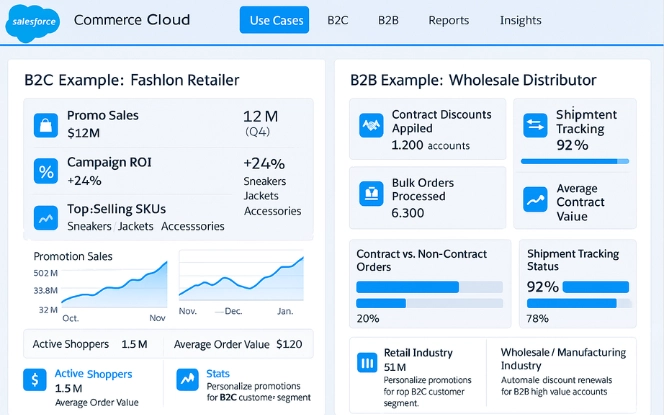
Examples show how each platform works in practice.
- B2C Example: A fashion retailer uses B2C Commerce Cloud to run seasonal promotions. Shoppers see personalized recommendations, check out quickly, and earn loyalty points.
- B2C Example: A consumer electronics brand offers consistent experiences across website, app, and physical stores.
- B2B Example: A wholesale distributor uses B2B Commerce Cloud for corporate accounts. Buyers get negotiated discounts and can reorder products in bulk.
- B2B Example: A manufacturer provides self-service portals. Procurement teams track orders, approvals, and invoices online.
These use cases highlight why a business must select the platform that reflects its customer journey.
Challenges and Considerations
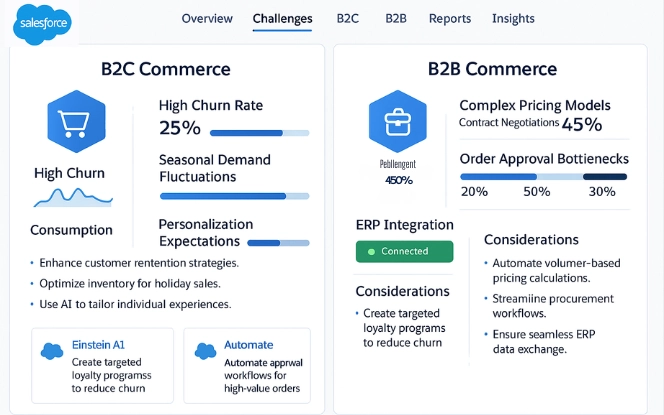
Choosing between B2B and B2C comes with challenges.
- Complexity: B2B workflows are harder to implement. Approvals and contracts require training.
- Customer Expectations: B2C demands fast, mobile-friendly experiences. Falling short risks customer churn.
- Hybrid Models: Many companies serve both businesses and consumers. This means using two platforms or custom integrations.
- Scalability: Growth demands scalability. Both platforms can scale, but planning is critical.
Organizations must evaluate budgets, resources, and technical needs before deciding. The right choice depends on the primary customer base.
Pricing Models in Salesforce B2C vs B2B Commerce Cloud
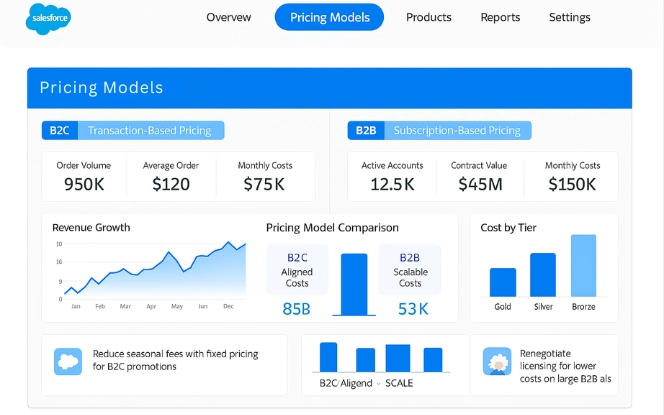
The pricing models in Salesforce B2C vs B2B Commerce Cloud highlight another major difference.
- B2C Pricing: Fixed prices with promotions, discounts, and loyalty programs. Easy for consumers to understand.
- B2B Pricing: Complex and negotiated. Buyers receive custom contracts, bulk discounts, and tiered pricing.
B2C pricing is transparent and uniform. B2B pricing is flexible but requires contract management. This distinction reflects the business models each platform supports.
Dive deeper into Salesforce REST API Integration Guide for Beginners to understand how digital commerce platforms shape competitive positioning.
Future Outlook
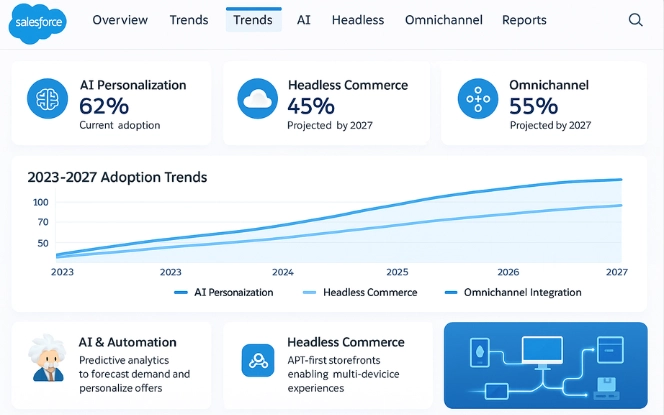
The future of Salesforce Commerce Cloud is shaped by advances in AI, omnichannel integration, and flexible commerce models. Businesses are no longer looking only at single-channel efficiency, they need platforms that unify every touchpoint while adapting to buyer behavior.
Emerging Trends:
AI Expansion: While B2C already benefits from AI-driven personalization, B2B is catching up. Predictive analytics will help companies forecast bulk order demand and manage contracts more intelligently.
Headless Commerce: Both B2B and B2C will rely more on headless setups, where APIs separate front-end and back-end systems, allowing brands to deliver experiences across multiple devices.
Omnichannel Growth: Customer journeys will be seamless across online stores, mobile apps, physical outlets, and even social platforms.
For B2C, this means faster adoption of mobile-first shopping and voice commerce. For B2B, it points to more automation in contracts, approvals, and logistics. Businesses that integrate these features now will be positioned to scale as commerce continues to evolve.
Companies choosing Salesforce today are investing in a platform that adapts to both immediate needs and long-term industry shifts.
Conclusion
The analysis of Salesforce B2C Commerce Cloud vs B2B Commerce shows that both platforms are powerful, but they serve different purposes. B2C focuses on speed, personalization, and consumer engagement, while B2B emphasizes contract pricing, bulk ordering, and account management.
Key Takeaways:
B2C: Best for high-volume consumer transactions with marketing integration.
B2B: Suited for large, complex orders that need efficiency and workflow automation.
Hybrid Models: Many businesses benefit from using both, ensuring coverage across all markets.
Choosing between the two depends on your primary customer base, integration needs, and scalability requirements. Organizations should also consider future growth, whether they expect expansion into consumer markets, enterprise sales, or both.
If your business is exploring Salesforce solutions, Contact us SDLC Corp for tailored advice. Our team can analyze your operations, recommend the right commerce model, and deliver seamless implementation.
For companies ready to enhance digital transformation, Hire Salesforce Developer with SDLC Corp to integrate intelligent automation into your commerce strategy. By combining the right platform with AI-driven insights, your organization can achieve sustainable growth and stay competitive in the digital economy.
FAQs
What Are The Key Differences Between Salesforce B2B And B2C Commerce?
The main difference lies in customer type and order management. B2C handles high-volume, small transactions for individual shoppers, while B2B supports bulk orders, contract pricing, and account management. Understanding the differences between Salesforce B2B and B2C Commerce helps businesses choose the right platform for their sales model.
How Does Salesforce B2B Commerce Cloud Order Volume Vs B2C Differ?
Salesforce B2B Commerce Cloud order volume vs B2C differs in both size and frequency. B2C processes millions of small, fast transactions. B2B focuses on fewer but larger and more complex orders that require approvals, custom pricing, and integration with ERP systems.
What Salesforce Commerce Cloud Features B2B Vs B2C Stand Out Most?
When comparing Salesforce Commerce Cloud features B2B vs B2C, the main differences are personalization and workflows. B2C emphasizes consumer personalization, marketing campaigns, and mobile-friendly checkout. B2B emphasizes bulk purchasing, contract management, and account-based pricing.
How Do Pricing Models In Salesforce B2C Vs B2B Commerce Cloud Compare?
The pricing models in Salesforce B2C vs B2B Commerce Cloud are very different. B2C relies on fixed product prices, discounts, and loyalty rewards. B2B uses contract pricing, tiered discounts, and bulk purchase agreements. The right model depends on the type of buyers served.
What Is The Technology Stack Comparison B2B Vs B2C Salesforce Commerce?
The technology stack comparison: B2B vs B2C Salesforce Commerce shows distinct integrations. B2C connects closely with Marketing Cloud and Service Cloud to drive consumer engagement. B2B integrates with ERP and logistics systems to manage large orders and contracts efficiently.

